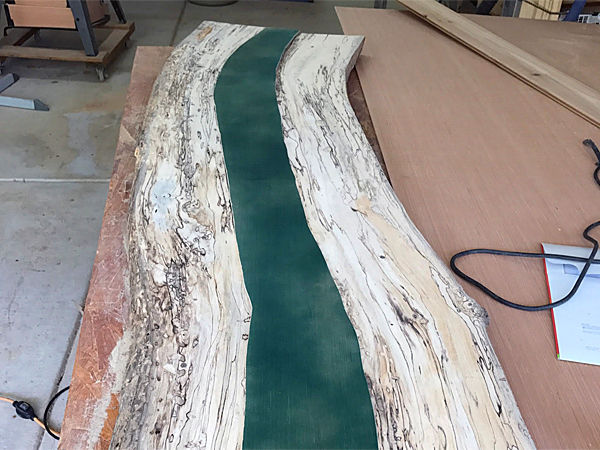
I am building a portable patio bar. Above is a photo of the 2-in.-thick slabs of spalted maple to be used as the 72-in. top. I would appreciate your recommendation on finishing this wood that would leave the color unchanged, be stout enough for a bar top, and endure the Texas heat being on the patio (probably will be covered when not in use). The surface has natural divots from the worm holes, which add interest but should be smoothed over by the finish. Additionally, both edges have live edges that need to be sealed and strengthened from being knocked off. – Harry Tennis
Tim Inman: Harry, you are going to have to compromise on your goals here. There ain’t no such finish that I know of that will do all you are asking. There are some things that will do most of it, but there is going to be that give-and-take that makes the final project what it is. Let’s look at your needs and wants here.
Spalted maple: any spalted wood is actually wood that has begun to rot. It is compromised. It is soft and spongy in places, and the more spalted, the spongier it is everywhere. Rotten wood depends upon the finish to make it hard. So, something that will soak in and harden is important. Anything that will soak in will “wet” the wood, and this causes color changes. Something “water clear” would be on the list. There are water white acrylic sealers out there. I would look for them. Acrylic is also pretty lightfast, which is important for your needs. Water-based products would tend to be more “water white” than solvent finishes, although water-based finishes contain ammonia, and ammonia can react with some woods to turn them dark, or black. Testing is important.
Heat is NOT your friend in anything, especially in finishing. Find ways to keep that surface cool, or be prepared to refinish or tolerate a surface you did not want. Filling and sealing the worm holes should not be hard. I would probably opt for a polyester filler because it is stable and reliable. Other finishes will bond to it, too. But your remark about the surface needing to be smoothed over by the finish bothers me a little. It makes me think you actually want a piano-grade finish on a patio deck table. This is a disaster waiting to happen.
The late finishing master, George Frank, once made this observation to a student when I was with him at a lecture demo series: When asked if French polishing was a tough and durable finish, George explained that although not very durable, French polish was by far the most elegant and beautiful finish possible when done correctly. George said, in his typically theatrical way, “You don’t go four-wheeling in a Rolls Royce!” I think I have to agree with his sentiments here: You can’t have a beautiful furniture finish on an outdoor table that will sit in the heat and rain and last very long. A marine spar finish would be very good for you, but it will need care, attention and periodic refreshing.
Chris Marshall: Two other options come to mind. Have you considered a marine-grade epoxy? That should fare well against rain and wetness, while also penetrating the wood to help strengthen it. Its thick viscosity also could help fill the worm holes, while building to a durable coating. But epoxy probably will give the wood an amber tint. Or, how about simply covering the top of this maple with a sheet of 1/8- or 1/4-in.-thick plastic instead and skipping the wood finish altogether? It would be rugged, spillproof and give you a smooth surface for serving. Cut it to shape with a jigsaw and a fine-tooth blade to match the top’s contours, then file or sand the edges smooth. It would only serve as a surface covering on top and not the edges, obviously, but if you cover up the bar up between uses, that might be all the surface protection you need.





